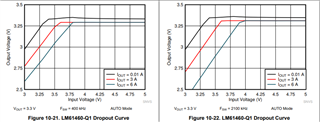Hi team,
My customer has some questions about chip spread spectrum, I hope I can help to answer them quickly:
1、The spread spectrum function of Auto mode is turned off in the light-load frequency reduction mode, and it is automatically turned on above the medium load. What kind of detection mechanism is this spread spectrum? What is the internal sense of the chip?
2、How does the chip itself judge that the load is above the medium load? How to judge the need for frequency spreading? Is Auto mode the same as FPWM?
Thanks!




